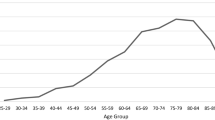Abstract
Objective: Little is known about the etiology of small bowel carcinoid tumor (SBC), but a few studies have pointed to certain medical and lifestyle factors as potential risk factors. This study aims to evaluate these findings and to identify new associations. Methods: A population-based European multicenter case–control study was conducted from 1995 through 1997. Incident histologically verified 35–69 year-old SBC cases (n = 99) and 3335 controls were recruited; 84 cases and 2070 controls were interviewed. Results: Ever being a smoker was associated with SBC (odds ratio = 1.9; 95% confidence interval 1.1–3.2) and increased risk estimates were seen for all smoking categories. SBC was associated with previous gallstone disease and ovariectomy, but only when these conditions occurred within two years prior to the SBC diagnosis. No association was seen for a history of cholecystitis, liver cirrhosis, ulcerative disease, or Crohn's disease. Intake of alcoholic beverages – as well as medical treatments with radioactive substances, hormones, or corticosteroid tablets – were not associated with SBC. Conclusions: This study indicates that tobacco smoking is a risk factor for SBC. The associations with gallstone and ovarian diseases may be due to enhanced medical surveillance during the early phase of the cancer disease.
Similar content being viewed by others
References
Modlin IM, Sandor A (1997) An analysis of 8305 cases of carcinoid tumors. Cancer 79: 813_829.
Burke AP, Thomas RM, Elsayed AM, Sobin LH (1997) Carcinoids of the jejunum and ileum: an immunohistochemical and clinicopathologic study of 167 cases. Surg Endosc 79: 1086_1093.
Stang A, Stegmaier C, Eisinger B, Stabenow R, Metz KA, Jo¨ ckel K-H (1999) Descriptive epidemiology of small intestinal malignancies: the German Cancer Registry experience. Br J Cancer 80: 1440_1444. Risk factors for small bowel carcinoid tumor 33
Sindelar WF (1989) Cancer of the small intestine. In: Devita VT et al., eds. Cancer: Principles and Practice of Oncology, 3rd. edn. Philadelphia: Lippincott, pp. 875_894.
Chen CC, Neugut AI, Rotterdam H (1994) Risk factors for adenocarcinomas and malignant carcinoids of the small intestine: preliminary findings. Cancer Epidemiol Biomarkers Prev 3: 205_207.
Johansen C, Chow WH, Jorgensen T, Mellemkjaer L, Engholm G, Olsen JH (1996) Risk of colorectal cancer and other cancers in patients withgall stones. Gut 39: 439_443.
Mellemkjaer L, Johansen C, Gridley G, Linet MS, Kjaer SK, Olsen JH (2000) Crohn's disease and cancer risk (Denmark). Cancer Causes Control 11: 145_150.
Griffiths DFR, Williams GT, Williams ED (1987) Duodenal carcinoid tumours, phaeochromocytoma and neurofibromatosis: islet cell tumour, phaeochromocytoma and the Von Hippel_Lin-Lindau complex: two distinctive neuroendocrine syndromes. Q J Med 64: 769_782.
Gardiner GW, Van Patter T, Murray D (1985) Atypical carcinoid tumor of the small bowel complicating celiac disease. Cancer 56: 2716_2722.
Kærlev L, Teglbjærg PS, Sabroe S, et al. (2000) Is there an association between alcohol intake or smoking and small bowel adenocarcinomaåresults from a European multi-center case_concontrol study. Cancer Causes Control 11: 791_797.
Kærlev L, Teglbjærg PS, Sabroe S, et al. (2000) Occupation and small bowel adenocarcinoma: a European case_control study. Occup Env Med 11: 760_766.
World HealthOrganisation (1976) ICD-O (International Classifi-cation of Diseases for Oncology). Geneva: WHO.
Percy C, Van Holten V, Muir C, eds. (1990) ICD-O (International Classification of Diseases for Oncology). Geneva: World Health Organization (WHO).
Maldonado G, G reenland S (1993) Simulation study of confounder-selection strategies. Am J Epidemiol 138: 923_936.
da Costa Pereira A, Olsen J, Ogston S (1993) Variability of self reported measures of alcohol consumption: implications for the association between drinking in pregnancy and birthweigh t. J Epidemiol Commun Health 47: 326_330.
International Agency for Researchon Cancer (1995) European Network of Cancer Registries, ''EUROCIM''. Users' manual, 2nd edn. Lyon: IARC.
Jorgensen T, Jensen KH (1991) Who has gallstones? Recent epidemiological studies. Ugeskr Laeger 153: 2612_2617.
O'Rourke MG, Lancashire RP, Vattoune JR (1986) Carcinoid of the small intestine. Aust NZ J Surg 56: 405_408.
Author information
Authors and Affiliations
Rights and permissions
About this article
Cite this article
Kaerlev, L., Teglbjaerg, P.S., Sabroe, S. et al. The importance of smoking and medical history for development of small bowel carcinoid tumor: a European population-based case–control study. Cancer Causes Control 13, 27–34 (2002). https://doi.org/10.1023/A:1013922226614
Issue Date:
DOI: https://doi.org/10.1023/A:1013922226614



